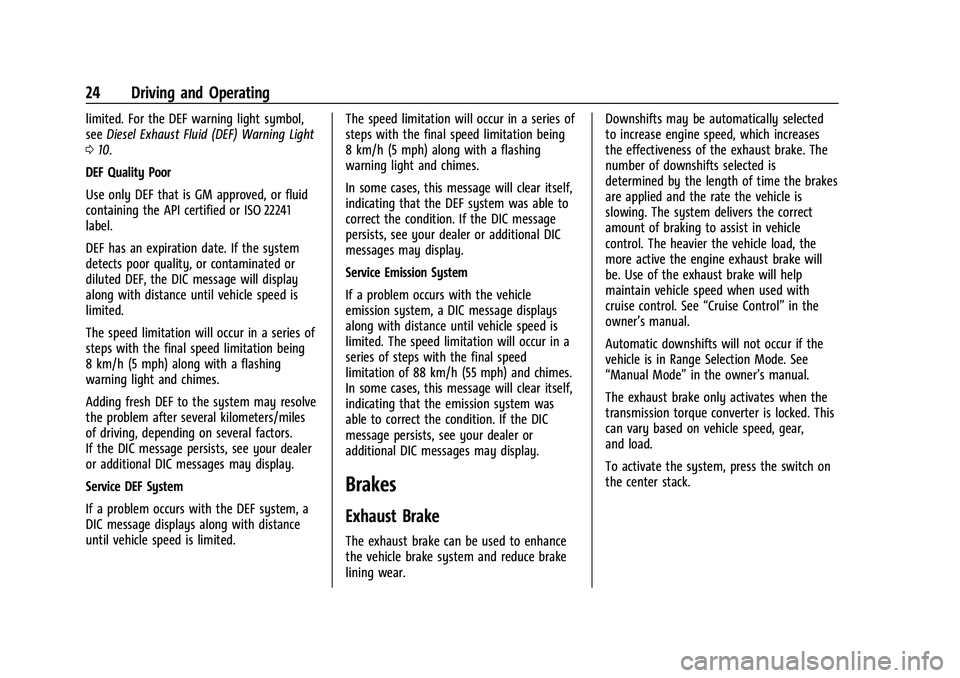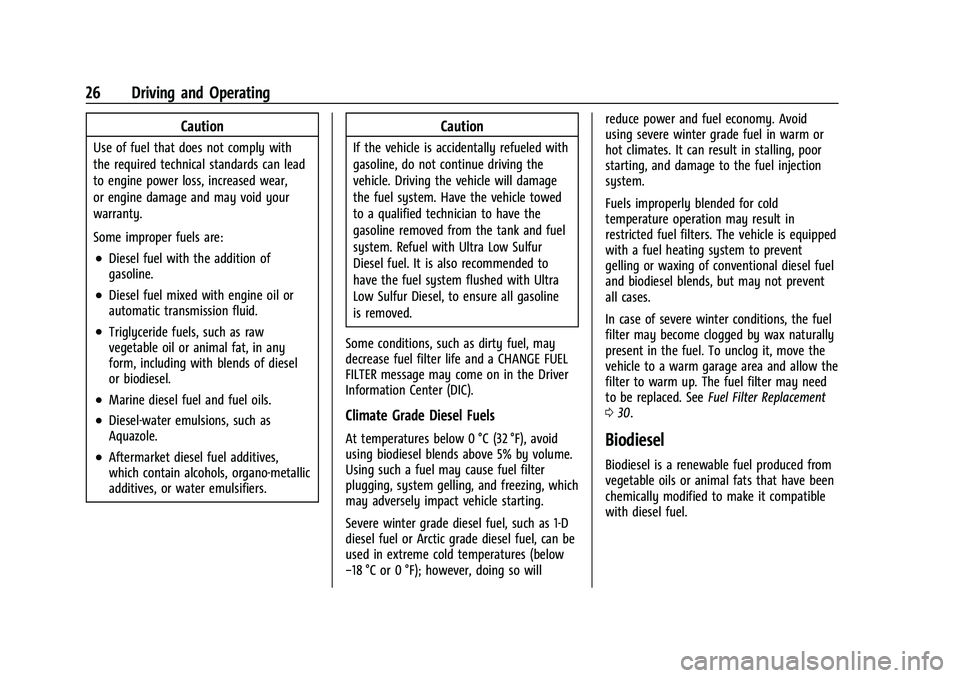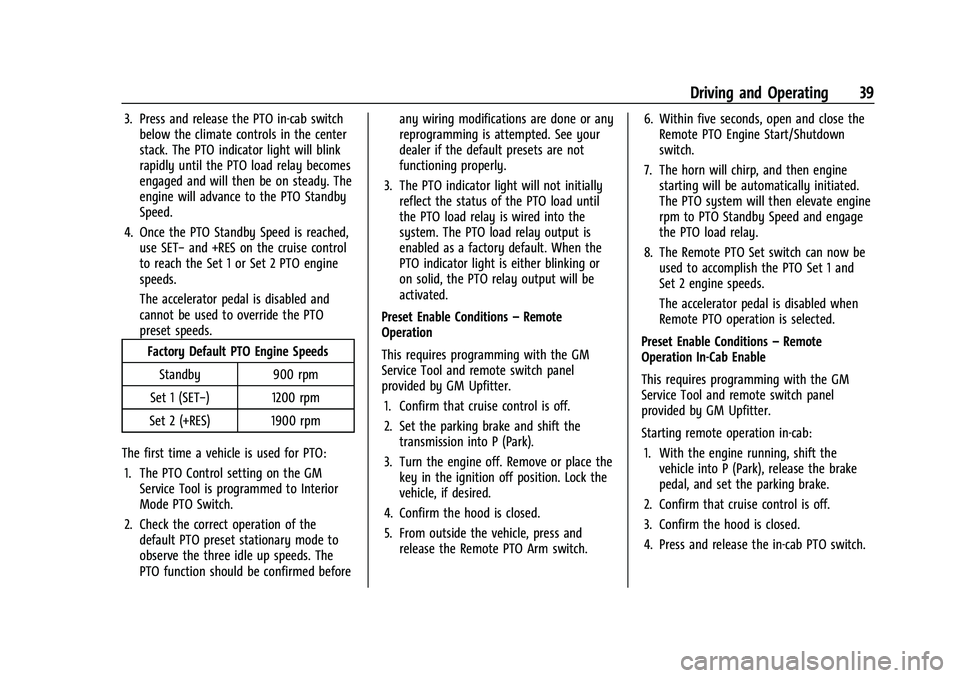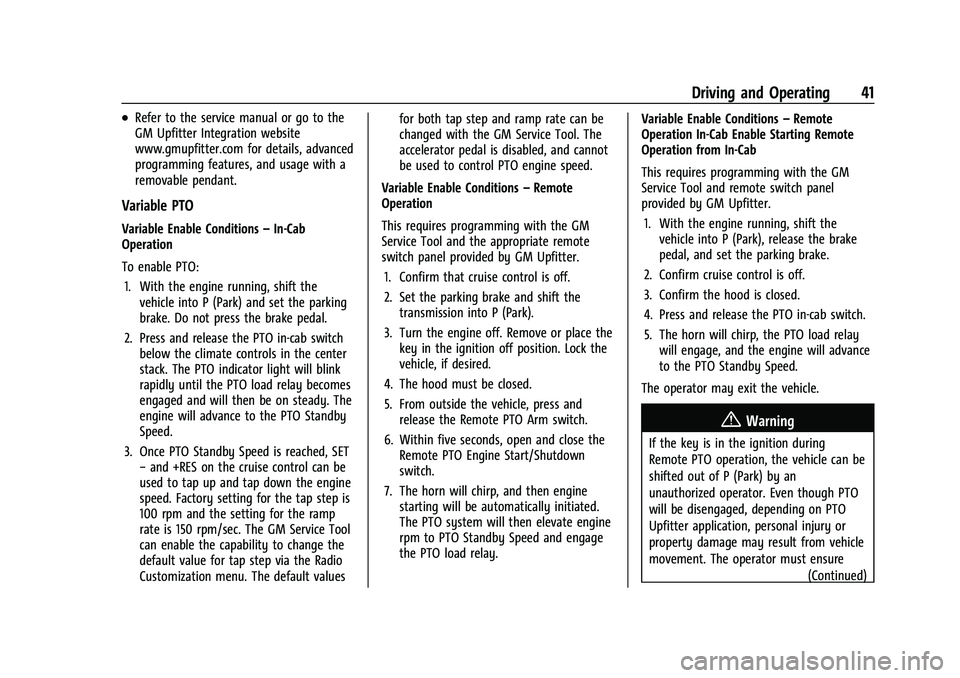2021 CHEVROLET COLORADO automatic transmission
[x] Cancel search: automatic transmissionPage 25 of 89

Chevrolet/GMC 2.8L Duramax Diesel Engine Supplement (GMNA-Localizing-
U.S./Canada-14465442) - 2021 - CRC - 2/3/20
24 Driving and Operating
limited. For the DEF warning light symbol,
seeDiesel Exhaust Fluid (DEF) Warning Light
0 10.
DEF Quality Poor
Use only DEF that is GM approved, or fluid
containing the API certified or ISO 22241
label.
DEF has an expiration date. If the system
detects poor quality, or contaminated or
diluted DEF, the DIC message will display
along with distance until vehicle speed is
limited.
The speed limitation will occur in a series of
steps with the final speed limitation being
8 km/h (5 mph) along with a flashing
warning light and chimes.
Adding fresh DEF to the system may resolve
the problem after several kilometers/miles
of driving, depending on several factors.
If the DIC message persists, see your dealer
or additional DIC messages may display.
Service DEF System
If a problem occurs with the DEF system, a
DIC message displays along with distance
until vehicle speed is limited. The speed limitation will occur in a series of
steps with the final speed limitation being
8 km/h (5 mph) along with a flashing
warning light and chimes.
In some cases, this message will clear itself,
indicating that the DEF system was able to
correct the condition. If the DIC message
persists, see your dealer or additional DIC
messages may display.
Service Emission System
If a problem occurs with the vehicle
emission system, a DIC message displays
along with distance until vehicle speed is
limited. The speed limitation will occur in a
series of steps with the final speed
limitation of 88 km/h (55 mph) and chimes.
In some cases, this message will clear itself,
indicating that the emission system was
able to correct the condition. If the DIC
message persists, see your dealer or
additional DIC messages may display.
Brakes
Exhaust Brake
The exhaust brake can be used to enhance
the vehicle brake system and reduce brake
lining wear.Downshifts may be automatically selected
to increase engine speed, which increases
the effectiveness of the exhaust brake. The
number of downshifts selected is
determined by the length of time the brakes
are applied and the rate the vehicle is
slowing. The system delivers the correct
amount of braking to assist in vehicle
control. The heavier the vehicle load, the
more active the engine exhaust brake will
be. Use of the exhaust brake will help
maintain vehicle speed when used with
cruise control. See
“Cruise Control”in the
owner’s manual.
Automatic downshifts will not occur if the
vehicle is in Range Selection Mode. See
“Manual Mode” in the owner’s manual.
The exhaust brake only activates when the
transmission torque converter is locked. This
can vary based on vehicle speed, gear,
and load.
To activate the system, press the switch on
the center stack.
Page 27 of 89

Chevrolet/GMC 2.8L Duramax Diesel Engine Supplement (GMNA-Localizing-
U.S./Canada-14465442) - 2021 - CRC - 2/3/20
26 Driving and Operating
Caution
Use of fuel that does not comply with
the required technical standards can lead
to engine power loss, increased wear,
or engine damage and may void your
warranty.
Some improper fuels are:
.Diesel fuel with the addition of
gasoline.
.Diesel fuel mixed with engine oil or
automatic transmission fluid.
.Triglyceride fuels, such as raw
vegetable oil or animal fat, in any
form, including with blends of diesel
or biodiesel.
.Marine diesel fuel and fuel oils.
.Diesel-water emulsions, such as
Aquazole.
.Aftermarket diesel fuel additives,
which contain alcohols, organo-metallic
additives, or water emulsifiers.
Caution
If the vehicle is accidentally refueled with
gasoline, do not continue driving the
vehicle. Driving the vehicle will damage
the fuel system. Have the vehicle towed
to a qualified technician to have the
gasoline removed from the tank and fuel
system. Refuel with Ultra Low Sulfur
Diesel fuel. It is also recommended to
have the fuel system flushed with Ultra
Low Sulfur Diesel, to ensure all gasoline
is removed.
Some conditions, such as dirty fuel, may
decrease fuel filter life and a CHANGE FUEL
FILTER message may come on in the Driver
Information Center (DIC).
Climate Grade Diesel Fuels
At temperatures below 0 °C (32 °F), avoid
using biodiesel blends above 5% by volume.
Using such a fuel may cause fuel filter
plugging, system gelling, and freezing, which
may adversely impact vehicle starting.
Severe winter grade diesel fuel, such as 1-D
diesel fuel or Arctic grade diesel fuel, can be
used in extreme cold temperatures (below
−18 °C or 0 °F); however, doing so will reduce power and fuel economy. Avoid
using severe winter grade fuel in warm or
hot climates. It can result in stalling, poor
starting, and damage to the fuel injection
system.
Fuels improperly blended for cold
temperature operation may result in
restricted fuel filters. The vehicle is equipped
with a fuel heating system to prevent
gelling or waxing of conventional diesel fuel
and biodiesel blends, but may not prevent
all cases.
In case of severe winter conditions, the fuel
filter may become clogged by wax naturally
present in the fuel. To unclog it, move the
vehicle to a warm garage area and allow the
filter to warm up. The fuel filter may need
to be replaced. See
Fuel Filter Replacement
0 30.Biodiesel
Biodiesel is a renewable fuel produced from
vegetable oils or animal fats that have been
chemically modified to make it compatible
with diesel fuel.
Page 40 of 89

Chevrolet/GMC 2.8L Duramax Diesel Engine Supplement (GMNA-Localizing-
U.S./Canada-14465442) - 2021 - CRC - 2/3/20
Driving and Operating 39
3. Press and release the PTO in-cab switchbelow the climate controls in the center
stack. The PTO indicator light will blink
rapidly until the PTO load relay becomes
engaged and will then be on steady. The
engine will advance to the PTO Standby
Speed.
4. Once the PTO Standby Speed is reached, use SET− and +RES on the cruise control
to reach the Set 1 or Set 2 PTO engine
speeds.
The accelerator pedal is disabled and
cannot be used to override the PTO
preset speeds.
Factory Default PTO Engine Speeds
Standby 900 rpm
Set 1 (SET−) 1200 rpm
Set 2 (+RES) 1900 rpm
The first time a vehicle is used for PTO: 1. The PTO Control setting on the GM Service Tool is programmed to Interior
Mode PTO Switch.
2. Check the correct operation of the default PTO preset stationary mode to
observe the three idle up speeds. The
PTO function should be confirmed before any wiring modifications are done or any
reprogramming is attempted. See your
dealer if the default presets are not
functioning properly.
3. The PTO indicator light will not initially reflect the status of the PTO load until
the PTO load relay is wired into the
system. The PTO load relay output is
enabled as a factory default. When the
PTO indicator light is either blinking or
on solid, the PTO relay output will be
activated.
Preset Enable Conditions –Remote
Operation
This requires programming with the GM
Service Tool and remote switch panel
provided by GM Upfitter.
1. Confirm that cruise control is off.
2. Set the parking brake and shift the transmission into P (Park).
3. Turn the engine off. Remove or place the key in the ignition off position. Lock the
vehicle, if desired.
4. Confirm the hood is closed.
5. From outside the vehicle, press and release the Remote PTO Arm switch. 6. Within five seconds, open and close the
Remote PTO Engine Start/Shutdown
switch.
7. The horn will chirp, and then engine starting will be automatically initiated.
The PTO system will then elevate engine
rpm to PTO Standby Speed and engage
the PTO load relay.
8. The Remote PTO Set switch can now be used to accomplish the PTO Set 1 and
Set 2 engine speeds.
The accelerator pedal is disabled when
Remote PTO operation is selected.
Preset Enable Conditions –Remote
Operation In-Cab Enable
This requires programming with the GM
Service Tool and remote switch panel
provided by GM Upfitter.
Starting remote operation in-cab:
1. With the engine running, shift the vehicle into P (Park), release the brake
pedal, and set the parking brake.
2. Confirm that cruise control is off.
3. Confirm the hood is closed.
4. Press and release the in-cab PTO switch.
Page 42 of 89

Chevrolet/GMC 2.8L Duramax Diesel Engine Supplement (GMNA-Localizing-
U.S./Canada-14465442) - 2021 - CRC - 2/3/20
Driving and Operating 41
.Refer to the service manual or go to the
GM Upfitter Integration website
www.gmupfitter.com for details, advanced
programming features, and usage with a
removable pendant.
Variable PTO
Variable Enable Conditions–In-Cab
Operation
To enable PTO:
1. With the engine running, shift the vehicle into P (Park) and set the parking
brake. Do not press the brake pedal.
2. Press and release the PTO in-cab switch below the climate controls in the center
stack. The PTO indicator light will blink
rapidly until the PTO load relay becomes
engaged and will then be on steady. The
engine will advance to the PTO Standby
Speed.
3. Once PTO Standby Speed is reached, SET −and +RES on the cruise control can be
used to tap up and tap down the engine
speed. Factory setting for the tap step is
100 rpm and the setting for the ramp
rate is 150 rpm/sec. The GM Service Tool
can enable the capability to change the
default value for tap step via the Radio
Customization menu. The default values for both tap step and ramp rate can be
changed with the GM Service Tool. The
accelerator pedal is disabled, and cannot
be used to control PTO engine speed.
Variable Enable Conditions –Remote
Operation
This requires programming with the GM
Service Tool and the appropriate remote
switch panel provided by GM Upfitter.
1. Confirm that cruise control is off.
2. Set the parking brake and shift the transmission into P (Park).
3. Turn the engine off. Remove or place the key in the ignition off position. Lock the
vehicle, if desired.
4. The hood must be closed.
5. From outside the vehicle, press and release the Remote PTO Arm switch.
6. Within five seconds, open and close the Remote PTO Engine Start/Shutdown
switch.
7. The horn will chirp, and then engine starting will be automatically initiated.
The PTO system will then elevate engine
rpm to PTO Standby Speed and engage
the PTO load relay. Variable Enable Conditions
–Remote
Operation In-Cab Enable Starting Remote
Operation from In-Cab
This requires programming with the GM
Service Tool and remote switch panel
provided by GM Upfitter.
1. With the engine running, shift the vehicle into P (Park), release the brake
pedal, and set the parking brake.
2. Confirm cruise control is off.
3. Confirm the hood is closed.
4. Press and release the PTO in-cab switch.
5. The horn will chirp, the PTO load relay will engage, and the engine will advance
to the PTO Standby Speed.
The operator may exit the vehicle.
{Warning
If the key is in the ignition during
Remote PTO operation, the vehicle can be
shifted out of P (Park) by an
unauthorized operator. Even though PTO
will be disengaged, depending on PTO
Upfitter application, personal injury or
property damage may result from vehicle
movement. The operator must ensure (Continued)
Page 45 of 89

Chevrolet/GMC 2.8L Duramax Diesel Engine Supplement (GMNA-Localizing-
U.S./Canada-14465442) - 2021 - CRC - 2/3/20
44 Driving and Operating
remain at curb idle. A press and release
of +RES on the cruise control will restore
engine rpm to the last PTO set speed. The
PTO system can also be programmed to
return engine rpm to the PTO Standby
Speed setting.
.Press*on the cruise control. The engine
returns to base idle, but the PTO load
relay remains engaged. The PTO indicator
light will blink slowly indicating that a
PTO set speed is still stored in memory.
Activating +RES on the cruise control will
restore engine rpm to the last PTO set
speed.
.Press and release the PTO in-cab switch.
The PTO load relay disengages and the
engine returns to base idle. The PTO
indicator light will turn off, indicating the
PTO load relay is disengaged and the
stored set speed has been cleared from
memory.
Stationary Modes (Preset or Variable) –
Remote Control
To disengage PTO:
.Open the Remote PTO Engine Start/
Shutdown switch. Load relay disengages
and the engine will stop.
.If equipped, press the PTO Emergency
Stop switch. Load relay disengages and
the engine will stop. Refer to the bulletins
in the GM Upfitter Integration website
www.gmupfitter.com for the Power
Take-Off (PTO) operating description and
application guide.
.With the key in the ignition and rotated
to the RUN position, press the brake
pedal. The PTO load relay disengages and
the engine returns to base idle speed. The
operator may drive the vehicle.
Stationary Modes will also disengage if:
.Vehicle movement is detected.
.The parking brake is released.
.The transmission is shifted out of
P (Park).
.The ignition is cycled from RUN to OFF.
.The PTO feedback signal is lost indicating
the load is disengaged if used. See
www.gmupfitter.com.
.Cruise control becomes enabled.
.Timed auto-engine shutdown: This feature
will shut down the engine automatically
after a predefined time. PTO must be
operational for this function to be active.
.Engine shutdown based on critical engine
or PTO system fault conditions: This
feature will shut down the engine when
PTO is operating if a critical engine
condition such as low oil, low oil pressure,
hot engine, hot transmission, low fuel,
or Diesel Particulate Filter regeneration is
detected by the vehicle system. If PTO
operation is continued when critical
engine conditions are present, a horn
chirp warning will occur after 30–
60 seconds. The engine will shut down
two minutes after the horn warning. The
engine can be restarted with the ignition
key or with the Remote PTO engine start
controls. The horn warning and engine
shutdown will again occur if the critical
engine condition is still present.
Resume memory speed is cleared for the
above actions.
When Remote PTO engine starting has been
initialized with the ignition key in the RUN
position, the shift lever will remain locked if
the brake pedal is pressed and a shift from
P (Park) is attempted while the engine is
running and PTO is active (standby mode).
A shift out of P (Park) will not be allowed
until one of the following actions is taken
by the vehicle operator:
Page 53 of 89

Chevrolet/GMC 2.8L Duramax Diesel Engine Supplement (GMNA-Localizing-
U.S./Canada-14465442) - 2021 - CRC - 2/3/20
52 Vehicle Care
Vehicle Care
General Information
Accessories and Modifications . . . . . . . . . . 52
Vehicle Checks
Engine Compartment Overview . . . . . . . . . 53
Engine Oil . . . . . . . . . . . . . . . . . . . . . . . . . . . . . . 55
Engine Oil Life System . . . . . . . . . . . . . . . . . 58
Automatic Transmission Fluid . . . . . . . . . . 58
Engine Air Cleaner/Filter . . . . . . . . . . . . . . . . 58
Cooling System . . . . . . . . . . . . . . . . . . . . . . . . 60
Engine Overheating . . . . . . . . . . . . . . . . . . . . 62
Battery (4-Cylinder Pickup Only) . . . . . . . . 63
Electrical System
Engine Compartment Fuse Block . . . . . . . 64
Appearance Care
Exterior Care . . . . . . . . . . . . . . . . . . . . . . . . . . . . 71
General Information
Accessories and Modifications
Adding non-dealer accessories or making
modifications to the vehicle can affect
vehicle performance and safety, including
such things as airbags, braking, stability,
ride and handling, emissions systems,
aerodynamics, durability, and electronic
systems like antilock brakes, traction control,
and stability control. These accessories or
modifications could even cause malfunction
or damage not covered by the vehicle
warranty.
Damage to vehicle components resulting
from modifications or the installation or use
of non-GM certified parts, including control
module or software modifications, is not
covered under the terms of the vehicle
warranty and may affect remaining
warranty coverage for affected parts.
GM Accessories are designed to complement
and function with other systems on the
vehicle. See your dealer to accessorize the
vehicle using genuine GM Accessories
installed by a dealer technician.
See the warranty manual.
Aftermarket Engine Performance
Enhancement Products and Modifications
Some aftermarket engine performance
products and modifications promise a way
to increase the horsepower and torque
levels of the vehicle's powertrain. You should
be aware that these products could have
harmful effects on the performance and life
of the engine, exhaust emission system,
transmission, and drivetrain. The engine,
transmission, and drivetrain have been
designed and built to offer industry leading
durability and performance in the most
demanding applications. Engine power
enhancement products may enable the
engine to operate at horsepower and torque
levels that could damage, create failure,
or reduce the life of the engine, engine
emission system, transmission, and
drivetrain. Damage, failure, or reduced life of
the engine, transmission, emission system,
drivetrain, or other vehicle components
caused by aftermarket engine performance
enhancement products or modifications
might not be covered under the vehicle
warranty.
Page 59 of 89

Chevrolet/GMC 2.8L Duramax Diesel Engine Supplement (GMNA-Localizing-
U.S./Canada-14465442) - 2021 - CRC - 2/3/20
58 Vehicle Care
engine at extremely low temperatures.
When selecting an oil of the appropriate
viscosity grade, it is recommended to select
an oil of the correct specification. See
“Specification”earlier in this section.
Engine Oil Additives/Engine Oil Flushes
Do not add anything to the oil. The
recommended oils meeting the dexos2
specification are all that is needed for good
performance and engine protection.
Engine oil system flushes are not
recommended and could cause engine
damage not covered by the vehicle
warranty.
What to Do with Used Oil
Used engine oil contains certain elements
that can be unhealthy for your skin and
could even cause cancer. Do not let used oil
stay on your skin for very long. Clean your
skin and nails with soap and water, or a
good hand cleaner. Wash or properly
dispose of clothing or rags containing used
engine oil. See the manufacturer's warnings
about the use and disposal of oil products.
Used oil can be a threat to the environment.
If you change your own oil, be sure to drain
all the oil from the filter before disposal. Never dispose of oil by putting it in the
trash or pouring it on the ground, into
sewers, or into streams or bodies of water.
Recycle it by taking it to a place that
collects used oil.
Engine Oil Life System
The engine oil life system calculates engine
oil life based on vehicle use and displays the
CHANGE ENGINE OIL SOON message when it
is time to change the engine oil and filter.
The oil life system should be reset to 100%
only following an oil change. See
“Engine Oil
Life System” in the owner’s manual.
Automatic Transmission Fluid
When to Check and Change (2.8L
4-Cylinder Engine Pickup Models)
See“Automatic Transmission Fluid” in the
owner’s manual.
When to Check and Change (2.8L
4-Cylinder Engine Van Models)
It is not necessary to check the transmission
fluid level. A transmission fluid leak is the
only reason for fluid loss. If a leak occurs,
take the vehicle to your dealer and have it
repaired as soon as possible. There is a special procedure for checking and
changing the transmission fluid. Because this
procedure is difficult, this should be done at
your dealer. Contact your dealer for
additional information.
Change the fluid and filter at the intervals
listed in
Maintenance Schedule 073 or
Maintenance Schedule 077, and be sure to
use the fluid listed in Recommended Fluids
and Lubricants 078.
Engine Air Cleaner/Filter
2.8L 4-Cylinder Engine Pickup Models
See “Engine Air Cleaner/Filter” in the
owner’s manual.
2.8L 4-Cylinder Engine Van Models
The air cleaner/filter assembly is on the
front of the engine compartment on the
driver side of the vehicle. See Engine
Compartment Overview 053.
When to Inspect/Replace the Engine Air
Cleaner/Filter
For intervals on changing and inspecting the
engine air filter, see Maintenance Schedule
0 73 or
Maintenance Schedule 077.
Page 77 of 89

Chevrolet/GMC 2.8L Duramax Diesel Engine Supplement (GMNA-Localizing-
U.S./Canada-14465442) - 2021 - CRC - 2/3/20
76 Service and Maintenance
Maintenance Schedule Additional
Required Services - Severe12 000 km/7,500 mi
24 000 km/15,000 mi
36 000 km/22,500 mi
48 000 km/30,000 mi 60 000 km/37,500 mi
72 000 km/45,000 mi84 000 km/52,500 mi
96 000 km/60,000 mi
108 000 km/67,500 mi 120 000 km/75,000 mi 132 000 km/82,500 mi
144 000 km/90,000 mi 156 000 km/97,500 mi
168 000 km/105,000 mi 180 000 km/112,500 mi
192 000 km/120,000 mi 204 000 km/127,500 mi 216 000 km/135,000 mi
228 000 km/142,500 mi
240 000 km/150,000 mi
Perform Required Services. Check engine oil level and oil
life percentage. Change engine oil and filter, if needed.@ @ @ @ @ @ @ @ @ @ @ @ @ @ @ @ @ @ @ @
Replace engine air cleaner filter. (1)@ @@
Change automatic transmission fluid and filter.@@@
Drain and fill engine cooling system. (2)@
Visually inspect accessory drive belts. (3)@
Replace timing belt.@
Replace fuel filter. (Pickup) (4)@@@@
Replace fuel filter. (Van) (4)@@@@@
Footnotes—Maintenance Schedule
Additional Required Services - Severe
(1) Or every four years, whichever comes
first. If driving in dusty conditions, inspect
the filter at each oil change or more often
as needed. See Engine Air Cleaner/Filter
0 58. (2)
Or every five years, whichever comes
first. See Cooling System 060.
(3) Or every 10 years, whichever comes first.
Inspect for fraying, excessive cracking,
or damage; replace, if needed. (4)
Or every two years, or when the
CHANGE FUEL FILTER message in the Driver
Information Center (DIC) comes on,
whichever comes first. The fuel filter may
need to be replaced more often based on
biodiesel usage, when driving in climates
with excessive dust, or when off-road driving
or towing a trailer for extended periods.